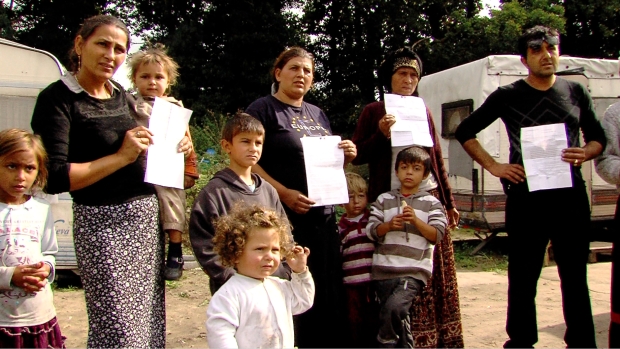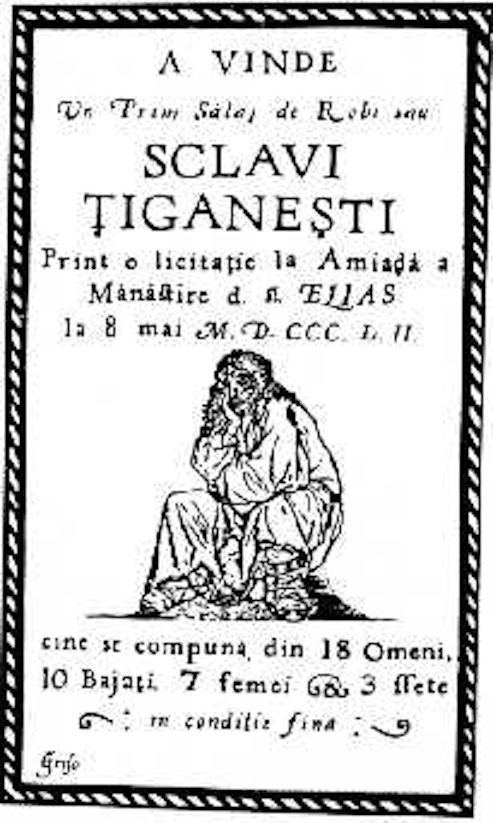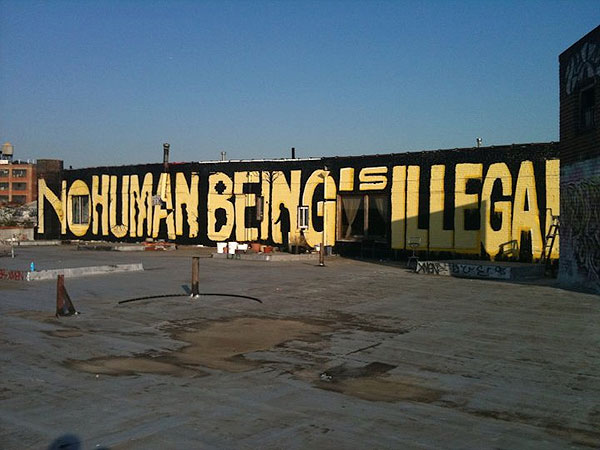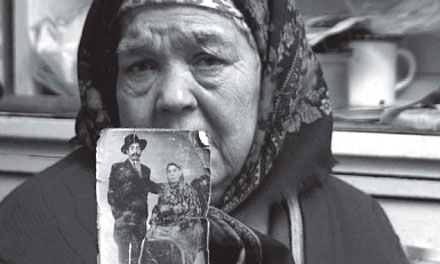Roma Slavery in the Romanian Territories: A Catch-22 of History and Recognition
“Madness! Madness! The hordes are at the gates!”
For almost five centuries, Roma lived as slaves in the Romanian Principalities, from the moment of their birth, as the code of Wallachia mentions in the 19th century. They were treated as objects with exchange value, being sold in auctions, donated, given as gifts at weddings, or simply used to repay debt. The slave was the master’s property, with no legal status. Marriage at a young age was encouraged, having as many children as possible being expected in order to increase the master’s property. Still not widely known, the details of the Roma slavery are one of the first institutionalised discriminatory practices against this group.
by Cristina Bangau
This part of history, the 500 years of Roma slavery – from their arrival to Europe around the 13th century, until the 19th century – has not been introduced yet in the school curriculum, Even if the long enslavement is almost singular to the Romanian territories – Moldavia and Wallachia, elsewhere in Europe they were the constant subject of cannibalism accusations, banned from entering cities, and even declared illegal. The fear of invasion, along the centuries, led to the development of all sorts of ‘protection’ measures, with the spectrum stretching from physical attacks to hate speech and its harrowing consequences. Nowadays, the segregation can still be physically mapped and only little progress has been made to include these accounts in the Romanian public discourse. An uncanny pattern of exclusionary practices can be noticed: from the upfront restriction of liberty, to the silencing of history transforming those accounts into marginalised memories, through a process of ordering, filtering, and hierarchizing of knowledge.
Nomads and Legislation
The right to freedom of movement in the European Union poses great challenges for national governments. The 2014 Swiss referendum[1], passing the proposal on immigration quotas, is just one of the most recent examples of what became an established trend, in the past years, of controlled and selective migration. Even though efforts are being taken to impose restrictions on Switzerland, as the cut-off from the Erasmus program of the university students, the hard-core nationalist voices are not shy to glorify the ‘bravery’ behind the act. The underlying message is one of fortifying the borders, of a careful selection of those who are to enter the promise land of Western Europe. By now, it is common knowledge that these juridically legitimized initiatives – if not specifically targeting – are mainly affecting the most disadvantaged social groups who, constrained by the jobless home environment, are looking for work opportunities abroad.
History does not fall short of cases in which the economic tensions were used as a fruitful background, politically mobilised as the most efficient strategy for keeping the migrants at bay. The findings of studies on the alarming rise of the right-wing political bodies in Europe are just one indicator of the ethnicization of economic inequalities. Relevant for this matter is the research undertaken by the Konrad Adenauer Stiftung, ‘Europe – No, Thanks? Study on the Rise of Right Wing and National Populist Parties in Europe’ (Grabow and Hartleb, 2014)[2]. From the disillusioned voters to the simplified media depiction of immigration issues and the failure to clearly communicate the advantages of European integration for all the citizens, the conditions for the changing political landscape are gaining more ground. The alarmist tone is overused, with a deliberately opaque description of the structural problems, that builds-up to an impending-doom atmosphere. In this scenario, the right-wing groups promote their intervention as ‘therapy’, an almost messianic mission to bring back to the people what is rightfully theirs, including protection from the ‘impure’ invaders. In the context in which Europe is still not fully recovered from the economic recession, the crisis of the integration process proves to be an exceptionally prolific starting point for authoritarian politics, like the heavy austerity measures – only one step away from demanding national protectionism and privileging the “own” economy, education etc[3]. If one treats the ‘Roma problem’ as a class issue, the main conflict appears to stem from economic inequality, masqueraded under a discourse of cultural differences, highly politicised to animate and legitimate extremist initiatives. At this point, revisiting what I consider the roots of early institutionalised discriminatory practices in Europe against the Romani population – the 500 years of slavery – can offer an incredibly rich source of understanding the past and its deep, current repercussions.

Taken from out film “Guilty Until Proven Innocent”. Roma families were abruptly expelled from France in the summer of 2010.
From Slavery to Repression: State Narratives
The political discourse changed tremendously over the centuries, with the idea of human rights being recently introduced in the public agenda. For example, the Universal Declaration of Human Rights – expressing the rights to which every human being is inherently entitled – was adopted only after the Second War World, in 1948[4]. It was to be the foundation for freedom, justice and peace, ensuring that every person is born free and equal, abolishing slavery and servitude. Anthropology 101 could easily let us know that what it is today unacceptable, was the norm at a certain point in time, and only recently questioned. Still, it is surprising that with the developments in today’s perception of ethnicity and the rejection of the taken for granted categories, the examples of exclusion, hate-speech, actions undertaken against entire groups in the name of heavily ideologized stereotypes are nonetheless thriving and, sometimes, not even recognised as such. A grim illustration of the silent normalisation of extremist attitudes and opinions can be found under the most mundane forms: internet comments. In the section for opinions and comments, at the end of media articles on the long history of the Roma slavery in the Romanian Principalities, some readers are openly stating that the only sad part about the Romani enslavement, from their perspective, was its abolition. A number of other comments were patronizing the daring act of Romani activism, associating Roma people with second-class citizens who should not have a saying in the matters of society. Most of all, since when do they have an informed opinion? Aren’t they supposed to be stealing something or destroy our calm as decent citizens?[5] Another comment shockingly hints at the day-to-come when the Indian Airlines will introduce the Bucharest – New Delhi route, a reference to the French cases of forced expulsion[6] – when a special charter was set up with the sole purpose of ensuring the success of the ‘voluntary returns’ – and the documented Indian origins of the Roma in the first centuries of the first millennium, before the migration to Europe.[7]
A short research on the topic reveals that media is booming with depictions of the inhumane conditions Roma population faces, nowadays. Unfortunately, history shows that this is not an isolated moment; ever since their arrival in Europe, Roma had been marginals. Valued for their craftsmanships, their passing through the Romanian Principalities (Wallachia and Moldavia) ended up in their enslavement. In an Europe awed by the invasion of the Turks, but not yet familiar with their appearances, Roma were sometimes confused with them and, consequently, feared. It was not long until they were banned, accused of cannibalism, compared to beasts, even outlawed. The dehumanizing accounts are countless; at the first outbreak of plague in Bucharest, the immediate measures taken were the expulsion of Roma from the city.
The date of 20th of February, the day in which in 1856 the slavery was officially terminated, has only recently been accepted by the Romanian state as the national day for the commemoration of the abolition of Roma slavery. In 2010 the legislative proposal[8] was still being rejected by the Senate on the grounds that it should not set a precedent for a direction that cannot be scientifically sustained, especially in an Europe so sensitive to the Roma related aspects[9]. The term ‘gypsy’ versus Roma was intensely debated, with Radu Berceanu, senator at that time, declaring that the measure based on which the latter was chosen, at a Parliamentary meeting of the Council of Europe, had no rigorous evidence. His remark was backed up by another senator, Hasoti, who blamed the previous Iliescu government for this ‘mistake’, stating that the term “tigan” (Romanian word for gypsy) had no pejorative overtone. Even if finally implemented, one year later, the proposal to introduce the history of the Roma slavery, in the Romanian principalities, in the school curriculum was rejected at the request of the Ministry of Education, Research, Youth and Sports. Instead, a ‘milder’ version was advanced, under the responsibility of the Ministry of Culture and National Patrimony, stating that financial support may be given, by central and local authorities, for social initiatives and public manifestations to commemorate, on the 20th of February, the abolition of the Roma slavery. This approach raises deeper concerns, about history and state intervention in shaping narratives that are to be read as the official state of things, painfully reminding of the similar attempts for the Roma Holocaust recognition. In this context of selective shadowing of the Roma history in the Romanian territory, is it such a surprise that its citizens are not seeing the full picture?
500 Years a Slave
The first documented mention of the Roma in the Romanian Principalities is actually as a gift given by the ruler, to monasteries, around the 14th century, but no other information about their previous legal status is made. The romanticised accounts of the nomadic Roma should not be confused with complete freedom; the masters offered a set of liberties, sometimes under the form of freedom to move around the territory, as long as an annual tax was being paid, the Roma enjoying a sort of judicial autonomy in the nomadic communities.[10] But, as previously mentioned, they had no status as legal persons, and were considered only as the masters’ property. This meant that the responsibility for their deeds was, officially, held by the owner. If a conflict was to arise between a slave and a free person, the trial was resolved between the master and that person. The option to just abandon the slave, if the owner did not want to pay the fine for them, was valid, unless a punishment was applied, sometimes even a capital one. However, if a slave had no master, they automatically became the slave of the Crown.
There are many criteria based on which they were grouped, the most common one being the belonging criterion. Roma were either slaves of the Crown, of the noblemen, or of the Church. Among these, the slaves of the Crown were enjoying the greatest array of liberties, being mainly nomads, while the others were working the land, offering domestic help, or performing different crafts. Along all these division lines, there was another one, referring to their occupation: the spoon-makers, working mostly with wood, the gold panners, ursari – training bears and making a living out of making them dance in villages, laieshi – who were usually settling at the outskirts of the villages, working with metal.
Slowly, the legislation made the Roma the property of the owners, slavery becoming entrenched in the social system of the Romanian principalities. What comes out of a context in which being a Roma becomes synonymous with being a slave? Exclusive property of the master, who but had the right over life and death, they could be sold in auctions, exchanged for cattle, donated, given as gifts, or simply used to repay debts. Revelatory for this is the story of the Stirbei boyar who, in 1834, organized an auction for his 3000 slaves in order to renovate his palace[11]. Imagine yourself being able to purchase a little Roma child for only 48 cents[12]! Along the years, prices varied, at a certain point becoming a Court’s responsibility to establish a fair price, based on age, health and skills.
Wanting to get married in the 18th century’s Romanian Principalities, let’s say as a Roma woman, could have been extremely weary. Not only that the masters had to give their permission but, if the partners separated, the children were to be shared equally between the owners. Plus, there is no guarantee that her, or any other member of the family will not be soon taken to a Sunday auction. Moreover, in the case in which a free person wanted to marry a slave, automatically that person became a slave, too, along with any child born from a Roma mother. Thinking about rebelling? The master, having complete rights over the slaves, could apply any punishment considered to be appropriate, from flogging, to the cutting of the lips and ears, whipping the sole of the feet, public beatings, the only constraint being not to kill the slave, action which, anyway, would have been counterproductive for the estate. It should not be ignored how valuable the Roma people were for a Medieval Europe, dominated by wars, decimated by plague, famine, conflicts. From their long journey from India, they brought along incredible skills, of utter value. Economically speaking, the Roma were essential because of their craftsmanship; they managed to fill in a niche that was not exploited in the agricultural society of Romanian principalities.
Around the 18th century, serfdom was abolished, more precisely in 1749, in Moldavia, time when it became explicitly stated that only Roma people were to be considered slaves, the serfs being free villagers owning no land. Finally, in the 19th century, animated by the European abolitionist movement, students started protesting in Bucharest, burning copies of the statutes referring to the status of Roma as slaves. It was not until 1860s that the claims became a reality, though compensated were the masters, now deprived of the cheap labour force, even after centuries of dehumanization. The abolition came only five centuries later, as a response to the freeing of the slaves in USA and introduction of mechanization. Started at the beginning of the 19th century, the final law that ensured slavery is completely eradicated, at least in the form known until then, was elaborated in 1864. Since then, the definition of slavery had been debated countless times, in order to make it more inclusive and updated to modern standards, nowadays referring to bondage, forced labour, and even arranged marriages.
Over centuries, the fear is still there, decried by the “respectable” European citizens. Revisiting the past shows how deeply rooted these reactions are. From German territories banning Roma in the 15th century, to the Bohemian land threatening with death all the Roma trespassers, these attitudes are nothing new. The debate of the freedom of movement in Europe slowly dilutes into the debate over the Roma problem. The prospects are quite grim. 600 years later, the mud huts at the end of the master’s estates, where the Roma were pushed, are transformed in ghettos, camps, settlements, improvised spaces or forced expulsions, as revealed by the French ‘voluntary returns’.

Romanian auction for Roma slaves.
Translation:
“18 Men,
10 boys, 7 women, 3 girls,
– In fine condition – “
A Whitewashed History
Too little is known about this part of the history, and very little steps towards integrating it in the dominant narrative are being taken. What was an intensely debated aspect in the 19th century, slowly lost any presence since the beginning the of 20th century, in the public discourse. Mihail Kogalniceanu, one of the most influential Romanian intellectuals of the 19th century, was the one responsible to draft the legislative document for the Roma slavery abolition. In 1891, at the 25th anniversary of the Romanian Academy, he pointed out in front of his colleagues and the Royal Family what he considered to be the three radical reforms[13] in the recent history of the modern Romania: the abolition of the Roma slavery, the emancipation of the peasantry, and the abolition of the nobility’s privileges. The implementation of those reforms were considered, at that time, the conditions of possibility that allowed for the formation of the modern Romanian Kingdom. Chronologically speaking, the abolitionist movement was finally reaching its goals in the USA only in the 1861, around the same time when the legislation regarding Roma slavery and the emancipation of the serfs was promulgated in the Romanian territories. However, in Romania, the official measures that targeted the Roma population did not stop. According to Viorel Achim, Romanian historian, in 1926 bio-politics and eugenics became institutionalized research fields, in the anthropological institutions of that time, with their own journal, published by the Institute of Social Hygiene (Achim, 2004: 164)[14]. In this context, the idea of ethnic minorities as a danger to the purity of the nation emerged. With the “Gypsy problem” being framed, solutions were soon proposed, such as sterilisation and encampment in isolated settlements. However, as Achim further points out, these ideas did not gain popularity, only the racial specialists being free to express their ‘scientific’ opinion, until the 1940s, when field-marshal Ion Antonescu took over, at the lead of an extreme right wing government. In 1942, approximately 25.000 Roma, mostly nomads, were deported to Transnistria (p. 169), the measure being rapidly abandoned, in October, the same year, and the “Gypsy problem”, in itself, slowly disappeared from the public discourse. A similar fate had these alternative accounts of the Romanian history that include the presence of the Roma minority. They are only briefly displayed in the official history taught in schools, as a singular case study of the 1938-1944 Romani and Jewish tragedy[15], with no mention of the 500 years long enslavement of the Roma population. As mentioned in the beginning, only from 2011 did the Romanian authorities finally make room for the commemoration of the Roma emancipation, in the public sphere. It almost feels as if the history itself is carefully scrutinized, undergoing a selective process of letting the right story in, while obscuring the parts that may ruin the smooth narrative.
[1] http://www.theguardian.com/world/2014/feb/09/swiss-referendum-immigration-quotas
[2] https://www.kas.de/wf/doc/kas_36200-544-2-30.pdf?140217120953
[4] http://www.un.org/en/documents/udhr/
[5]http://www.historia.ro/node/2373
[5.a]http://www.historia.ro/exclusiv_web/general/articol/calai-lautari-istoria-tiganilor-tarile-romane
[6] http://www.bbc.com/news/world-europe-11020429
[8] http://www.cdep.ro/comisii/drepturile_omului/pdf/2010/rp519.pdf
[9] http://acum.tv/articol/17851/
[11] http://www.oocities.org/~patrin/pariah-ch4.htm
[12] http://www.reocities.com/~patrin/pariah-ch3.htm
[14]Achim, Viorel. 2004. Roma in the Romanian History. Budapest: CEU Press.
[15] http://www.isjcta.ro/wp-content/uploads/2013/06/Programe-scolare-istorie-cls-V_VIII.pdf

